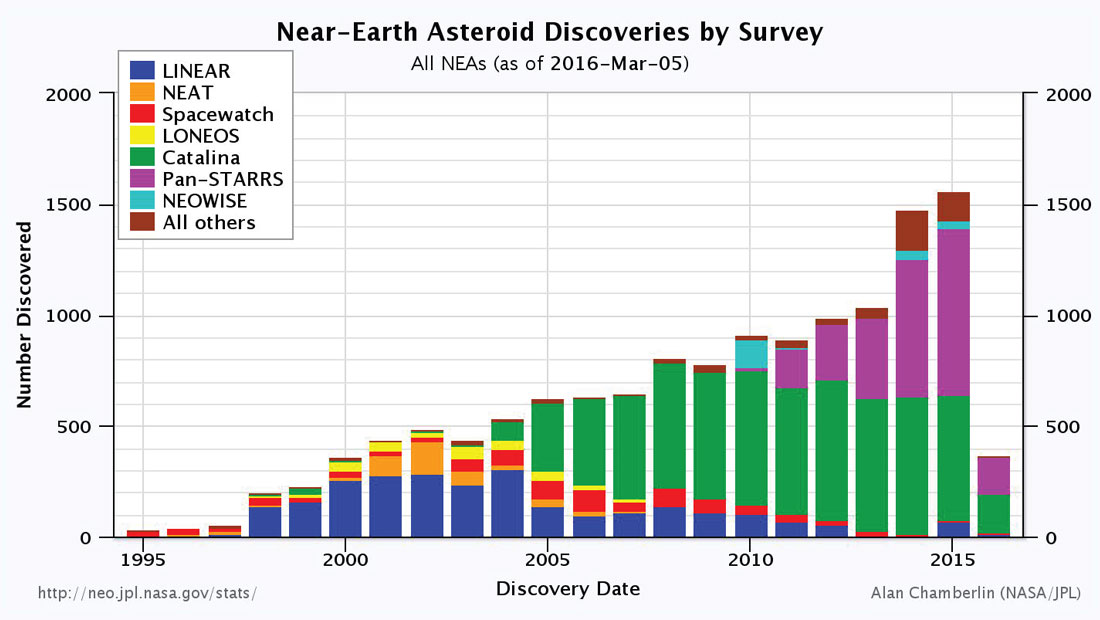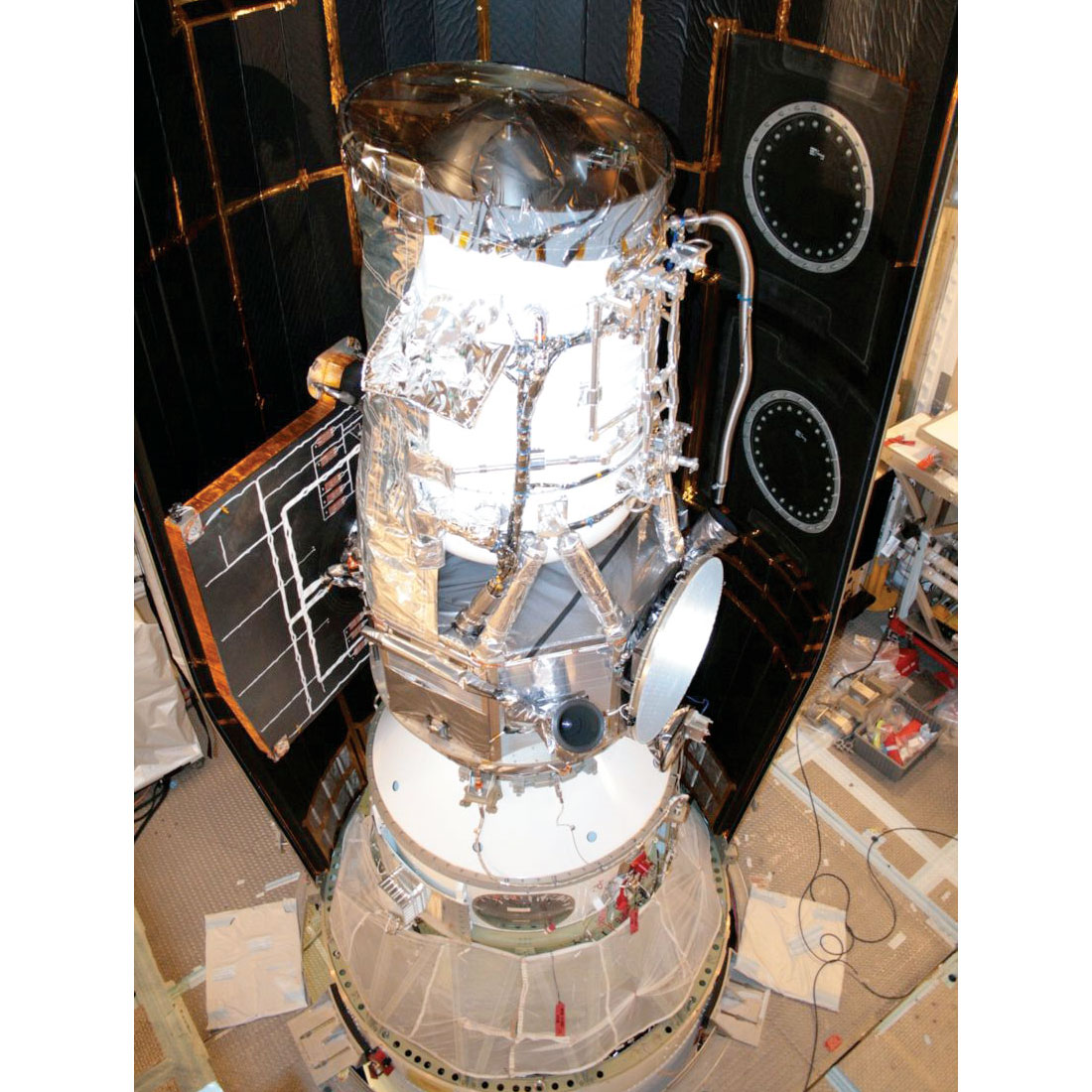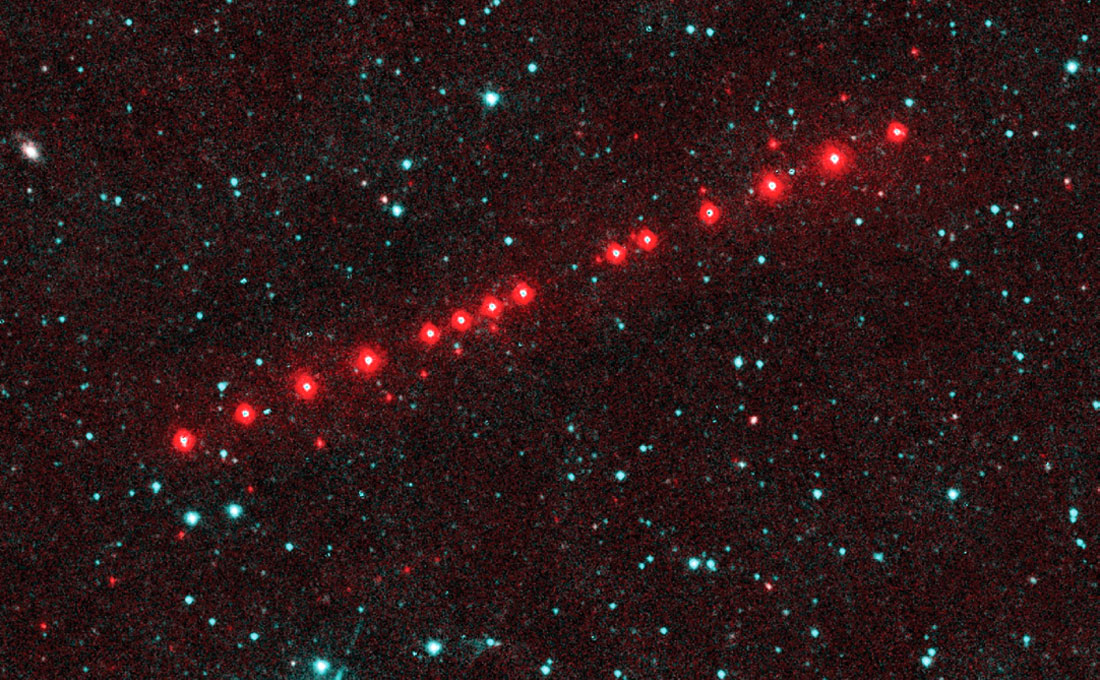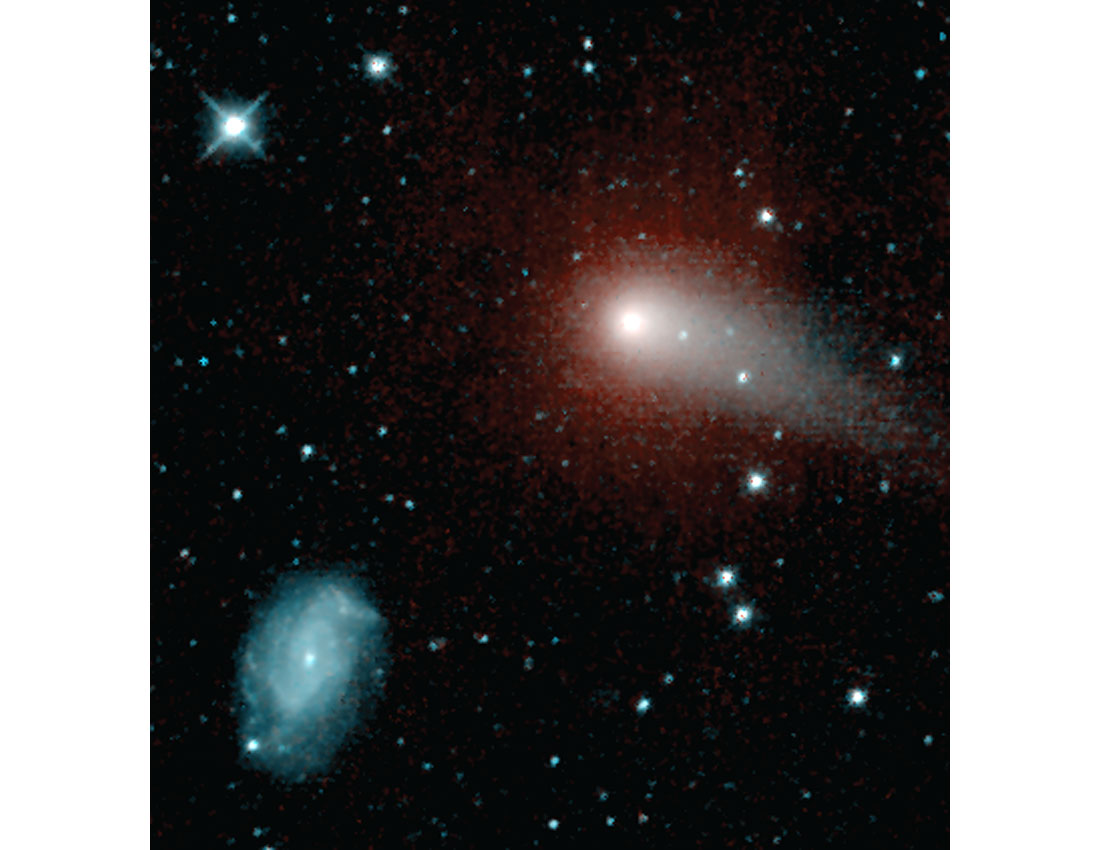In addition to its eight planets circling the Sun, our solar system teems with smaller bodies, asteroids and their more ice-rich cousins, the comets. The dominance of these so-called minor planets in terms of their sheer numbers provokes several seemingly simple questions about them: How many are there, did they form in place or migrate to their current locations, and is our solar system unique with regards to its minor planet populations? What is the physical and orbital nature of these objects, and do these properties ever change with time? How do interactions with the planets – or interactions between small bodies – influence the populations? And of course, the questions of interactions with one planet in particular are of special importance to its inhabitants.
Efforts to address these questions have focused on both detailed studies of individual objects in order to understand their detailed geophysical and dynamical histories as well as large-scale studies of minor planet populations. The latter are often accomplished by remote sensing, which allows orbits to be measured and physical properties to be probed for many objects. Survey projects allow the results from spacecraft visits to individual asteroids or comets to be placed into proper context with larger populations, given the vast diversity in terms of composition, shape, porosity, and density that has been noted among these objects.
Since the impact of Comet Shoemaker-Levy 9 into Jupiter in 1994 (Hammel et al. 1995, Zahnle & Mac Low 1994), there has been a renewed interest in surveys for minor planets, especially the population of near-Earth objects (NEOs, defined as asteroids and comets that come within 1.3 astronomical units of the Sun) that can potentially make close approaches to Earth. Shortly thereafter, the United States Congress tasked NASA with the goal of discovering more than 90% of large (kilometer-sized) near-Earth asteroids, the so-called Spaceguard goal. The advent of CCD imaging allowed for an explosive growth in the number of minor planets discovered, cataloged, and tracked, from roughly 300 NEOs in 1994 to ~14,000 in 2016 (Figure 1). As a byproduct of these NEO surveys, the number of objects known in the main asteroid belt also grew from ~20,000 to ~700,000 over the same time period. Meanwhile, Congress gave NASA the additional goal of discovering more than 90% of NEOs larger than 140 m in diameter by 2020, since these objects are large enough to cause severe regional damage. This goal was captured in the George E. Brown, Jr. section of the NASA Authorization Act of 2005 (Public Law 109-155).

The vast majority of the discoveries have been made by modest-sized (0.5-2 m class) ground-based telescopes operating at visible light wavelengths, which sense reflected sunlight. NASA-funded surveys such as LINEAR (Stokes et al. 2000), LONEOS, Spacewatch (Larson 2007, McMillan 2007), and NEAT (Helin et al. 1997) pioneered much of the growth in numbers of known NEOs. At present, many of these facilities have either been retired or have shifted their emphasis to follow up of objects discovered by the Catalina Sky Survey (Drake et al. 2009) and PanSTARRS surveys (Denneau et al. 2013) operating out of Arizona and Hawaii, respectively.
These ground-based surveys have recently been augmented by a space-based telescope operating at infrared wavelengths that is discovering and characterizing minor planets. The Wide-Field Infrared Survey Explorer (WISE; Principal Investigator: Dr. Edward Wright of UCLA) is a NASA Medium class Astrophysics Explorer mission that was designed to survey the entire sky in four infrared wavelengths simultaneously (Wright et al. 2010; Figure 2). Among its primary scientific objectives were the discovery of cool stars and ultra-luminous infrared galaxies. While the project was believed to be capable of measuring previously known asteroids, there was no plan to use the telescope to discover new ones. The original scientific objectives did not require saving the individual exposures of each part of the sky; instead, the planned data products were limited to coadded exposures that would have removed objects moving across the sky on timescales of hours (Cutri et al. 2012).

Recognizing the value of discovering asteroids using a space-based platform operating at wavelengths capable of sensing the heat emitted by asteroids instead of their reflected sunlight, a proposal was submitted to NASA’s Planetary Science Division in late 2007 to augment the WISE science data processing pipeline for solar system studies. Dubbed NEOWISE, these augmentations consisted of 1) creating an archive of individual exposures; 2) creating a tool for searching the single-exposure archive for detections of minor planets by names or orbital elements; 3) implementing a pipeline for actively extracting potential minor planet detections from the data in near real-time, allowing for the discovery of new asteroids and comets. The WISE Moving Object Processing System (WMOPS) detects minor planet candidates by comparing lists of detections and rejecting objects such as stars and galaxies that appear repeatedly at the same location on the sky. The remaining transient sources are linked into sets of position-time pairs if they can plausibly fit a trajectory consistent with an object moving across the sky. This set of position-time pairs is known as a tracklet (Figure 3).

WISE launched in December 2009 into a ~525 km sun-synchronous polar orbit with 6pm ascending node crossings, and it surveyed the entire sky at 3.4, 4.6, 12, and 22 μm over the course of six months after a one month in orbit checkout period. This space-based survey avoided the attenuation and thermal glow from the Earth’s atmosphere, providing sensitive simultaneous imaging in all four bands. Its two long wavelength detectors required cooling to ~8K; the optical system and shorter wavelength channels operated at ~17K and 32K, respectively. Cooling was accomplished using a dual stage solid hydrogen cryostat. The cryostat exceeded its required lifetime and was finally completely depleted on September 29, 2010.
WMOPS was deployed shortly after the start of survey operations and resulted in the detection of more than 158,000 minor planets during the prime mission phase in 2010-2011, a sample including hundreds of NEOs (Mainzer et al. 2011a). There are several advantages of detecting and discovering asteroids and comets at thermal infrared wavelengths. First, by detecting objects on the basis of their thermal emission rather than their reflected sunlight, NEOWISE is approximately equally sensitive to asteroids with dark, carbonaceous surfaces as well as lighter colored, rocky bodies. Moreover, as a space-based survey not subject to variations in weather or atmospheric seeing, the survey’s selection biases were consistent and easily computed. As a result, it was possible to obtain a reliable estimate of the ratio of dark to bright objects in the various small body populations, including the NEOs and main belt asteroids. Additionally, thermal infrared emission is strongly related to an object’s size, whereas the amount of visible light it reflects is degenerate with albedo and size. Thus, it is possible to estimate an asteroid’s effective spherical diameter to within ±10% using good quality thermal infrared measurements (Mainzer et al. 2011b). The mission expanded the sample of minor planets with well-determined diameters and albedos by nearly two orders of magnitude compared to the prior state of the art (Tedesco et al. 2002a, b).
The NEOWISE survey revealed that NEOs have a bimodal albedo distribution, and ~35% of NEOs are dark. The ratio of bright to dark objects in the NEO population remains relatively constant over a wide range of sizes, contradicting previous studies that found a strong correlation between size and reflectivity (e.g. Delbó et al. 2003). These studies were performed on samples selected by ground-based telescopes operating at visible light wavelengths; the NEOWISE infrared-selected sample showed that the apparent increase in albedo with decreasing object size was instead a function of selection effects, since visible light telescopes are less sensitive to small, dark objects. The NEOWISE NEO sample was also used to set constraints on the number of NEOs larger than 100 m that exist (20,500±3000), and showed that ~25% of this population has been discovered to date. NEOWISE data were also used to confirm that the Spaceguard goal was reached; sometime in 2010, more than 90% of near-Earth asteroids larger than 1 km were discovered (Mainzer et al. 2011c). When the population of NEOs on particularly close-approaching orbits were considered, the NEOWISE study found that those objects with orbital inclinations closest to Earth’s were underrepresented in population models by roughly a factor of two (Mainzer et al. 2012). These results have since been supported by researchers using other datasets (Greenstreet & Gladman 2013).
The mission has greatly expanded the sample of asteroids in the Main Belt with well-determined diameters and albedos, along with other diverse populations including the Jovian Trojans (asteroids in a 1:1 resonance with Jupiter), the Hilda-group asteroids (which occupy a 3:2 resonance with Jupiter), long- and short-period comets, and the distant Centaurs (Masiero et al. 2011; Grav et al. 2011, 2012; Bauer et al. 2011, 2012, 2015). By searching for objects in the Main Belt with similar orbits and WISE-measured albedos, researchers have associated tens of thousands of asteroids into scores of “families” produced by collisions that have happened over millions or even billions of years (Masiero et al. 2013, Milani et al. 2014). By extrapolating and debiasing the sample of WISE-observed Jovian Trojans, an asymmetry in the number of objects in the leading and trailing Trojan clouds was confirmed (Grav et al. 2011). Models of planet formation and migration will need to account for the observed difference.
Studies of the sample of comets have benefitted from the fact that the 4.6 μm WISE channel spans the emission features of two molecules abundant in comets: CO and CO2; both are thought to be significant drivers of cometary activity during close approaches to the Sun (Figure 4). The WISE sample was used to test whether or not there are differences in the abundance of CO and CO2 in short-versus long-period comets. Theory would suggest that long-period comets, which originate in the Oort Cloud and only rarely pass close to the Sun, would have more ices than the short-period comets, which make close approaches every few years. Yet surprisingly, this was not the case; both short- and long-period comets were found to produce similar quantities of CO and CO2 within 4 AU of the Sun (Bauer et al. 2015).

Following the depletion of its cryogen on October 5, 2010, NASA’s Planetary Science Division provided the resources to allow the mission to operate until February 1, 2011, completing the survey of the inner edge of the asteroid belt using the remaining 3.4 and 4.6 μm channels. This extra operational period serendipitously allowed for the discovery of the first known Earth Trojan asteroid, 2010 TK7, on the day after the cryogen was depleted. This object shares Earth’s orbit and librates ahead of our planet, having been temporarily captured (Connors et al. 2011).
After February 1, 2011, the spacecraft was placed into a hibernation state. It remained power positive, but the instrument was shut off, and communications with it ceased. The payload subsequently warmed to ~200 K. In late 2012, NASA requested a proposal from the team to restart the spacecraft for the purpose of discovering, characterizing, and tracking minor planets using the 3.4 and 4.6 μm channels. The team reactivated the spacecraft in 2013 despite the absence of cryogen by repointing the telescope at zenith, so that the payload reached ~74K by radiative cooling after 3-4 months (Mainzer et al. 2014). Six days after the survey restarted in December 2013, the newly renamed NEOWISE spacecraft (Principal Investigator: Dr. Amy Mainzer) discovered its first NEO, 2013 YP139. Since then, the mission has gone on to detect ~19,000 minor planets, including ~500 NEOs, of which 80 are new discoveries; the performance of the first two channels is essentially unchanged from the prime mission. As was the case during the fully cryogenic prime mission, NEOWISE NEO discoveries tend to be large and dark by virtue of the fact that it finds the asteroids on the basis of their thermal emission (Nugent et al. 2015). Therefore, NEOWISE complements the existing suite of visible light surveys. Orbital decay will eventually force an end to the mission; drag forces are causing the orbital plane to precess, and temperatures will consequently rise as sunlight and earthshine can no longer be avoided.
Because WISE/NEOWISE was never originally designed for asteroid study, it is intrinsically limited in the number of objects that it can detect. Moreover, the existing suite of surveys (including NEOWISE) will take 30-40 years to discover 90% of NEOs larger than 140 m (Grav et al. 2016). In 2005, our group began studying options for developing a new space telescope dedicated to the task of discovering and characterizing minor planets, particularly NEOs. This new mission, dubbed the Near-Earth Object Camera (NEOCam), was first proposed to NASA’s Discovery program in 2006. NEOCam is designed to improve upon WISE with regards to NEO discovery by moving the observatory from a Sun-synchronous low Earth orbit to the L1 Lagrange point, a semi-stable region of space located approximately five lunar distances away in the direction of the Sun. This orbit offers a stable thermal environment that, with appropriate thermal shielding, can allow much colder temperatures to be reached by virtue of being away from the heat of the Earth. Yet the spacecraft is close enough to enable high-rate downlinks of large format images, crucial for sifting through billions of sources to find faint new asteroids and comets. NEOCam takes advantage of modern megapixel infrared detectors that do not require cooling to ~8 K. Instead, the NEOCam arrays operate at 35-40K, temperatures achievable through passive radiative cooling as has been demonstrated by the Spitzer Space Telescope in its warm mission (Storrie-Lombardi & Dodd 2012). The proposal was resubmitted in 2010, and NASA awarded the team funding to mature the infrared detector arrays (McMurtry et al. 2013). After resubmitting in 2015, NEOCam advanced to a second round of competition along with four other proposed missions. Its primary scientific objective is to create the most comprehensive survey of our solar system’s small bodies in an effort to understand their origins, evolution, and frequency with which they impact Earth (Mainzer et al. 2015).
By leveraging the experience from the WISE/NEOWISE surveys, NEOCam is designed to deliver detections of millions of main belt asteroids and expand the number of NEOs known by nearly an order of magnitude. By detecting more than 2/3 of potentially hazardous NEOs during its five-year baseline mission, NEOCam would make considerable progress toward the George E. Brown, Jr. survey objective. Simultaneously, NEOCam would provide the scientific data needed to study the formation and evolution history of the asteroids and comets that come closest to the Earth. As we have learned, surveys such as NEOCam are a basic tool that can greatly advance our understanding of what is both common and unusual about Earth’s nearest neighbors, the asteroids and comets.

Acknowledgements
This publication makes use of data products from NEOWISE, which is a project of the Jet Propulsion Laboratory/California Institute of Technology, funded by the National Aeronautics and Space Administration. This publication makes use of data products from the Wide-field Infrared Survey Explorer, which is a joint project of the University of California, Los Angeles, and the Jet Propulsion Laboratory/California Institute of Technology, funded by the National Aeronautics and Space Administration.










Join the Conversation
Interested in starting, or contributing to a conversation about an article or issue of the RECORDER? Join our CSEG LinkedIn Group.
Share This Article